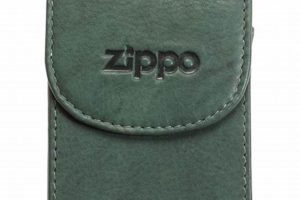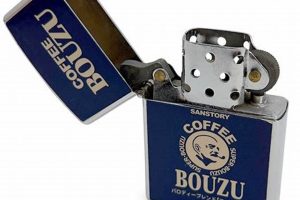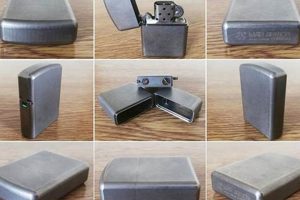Creating custom lighter casings for Zippo lighters involves designing and fabricating unique exteriors, often from materials like metal, wood, or acrylic. This can range from simple etching and painting to complex 3D-printed designs or intricate metalwork. An example would be crafting a brass casing engraved with a personalized design or repurposing a piece of hardwood into a rustic, natural cover.
Personalized lighter cases offer a way to express individuality and showcase craftsmanship. They can commemorate special events, display artistic talent, or simply provide a distinctive, tactile experience. This practice resonates with the historical appeal of Zippo lighters, known for their durability and refillable design, which lends itself to customization and long-term use. The ability to create a unique object contributes to the enduring popularity of these lighters.
This article will explore various methods for creating personalized lighter cases, ranging from beginner-friendly techniques to more advanced fabrication processes. Material selection, design considerations, and step-by-step instructions will be provided to guide readers through the process of crafting their own distinctive lighter cases.
Tips for Creating Custom Lighter Cases
Careful planning and execution are crucial for successful lighter case customization. The following tips offer guidance for achieving professional-looking results.
Tip 1: Material Selection: Consider the material’s durability, workability, and aesthetic qualities. Brass, copper, and stainless steel offer durability but require metalworking skills. Wood provides a natural aesthetic but requires sealing against moisture and heat. Acrylic allows for intricate designs through laser cutting or CNC machining.
Tip 2: Design Planning: Sketch the design beforehand, accounting for the lighter’s dimensions and functional elements like the hinge and flint wheel. Digital design software can aid in creating precise templates.
Tip 3: Surface Preparation: Thoroughly clean and prepare the base material. This may involve sanding, polishing, or degreasing to ensure proper adhesion of finishes or decorations.
Tip 4: Protective Measures: When working with metals, appropriate safety equipment like eye protection and gloves should be used. Adequate ventilation is essential when using adhesives, paints, or solvents.
Tip 5: Finishing Techniques: Explore various finishing options, such as polishing, painting, etching, or applying a patina. A clear coat sealant can protect the design and enhance its longevity.
Tip 6: Testing and Refinement: After completion, ensure the case fits snugly and does not interfere with the lighter’s functionality. Minor adjustments may be necessary for optimal fit and performance.
Tip 7: Heat Considerations: Remember that the lighter generates heat. Materials and adhesives should be chosen with appropriate heat resistance to prevent warping or degradation.
By following these tips, one can create a durable and aesthetically pleasing custom lighter case that reflects personal style and craftsmanship. Careful attention to detail throughout the process ensures a satisfying outcome.
Creating a custom lighter case offers a rewarding experience, allowing for the expression of personal creativity and the development of practical skills.
1. Design
Design plays a pivotal role in creating custom Zippo lighter cases, transforming a functional item into a personalized expression. A well-considered design elevates the aesthetic appeal and reflects the creator’s individual style. This section explores key facets of design in the context of customized lighter cases.
- Visual Elements:
Visual elements encompass the overall aesthetic, including imagery, patterns, and typography. A nature enthusiast might etch a floral design onto a brass case, while a minimalist might prefer a clean, geometric pattern on a stainless steel surface. The choice of visual elements significantly impacts the final appearance and reflects the individual’s artistic preferences.
- Material Considerations:
The chosen material influences the design’s feasibility and final effect. Intricate carvings are well-suited to wood, while metal allows for etching and embossing. Acrylic offers versatility for complex shapes and vibrant colors. The interaction between design and material choice is crucial for achieving the desired outcome. A Celtic knot design, for instance, might be carved into wood or etched onto metal, each offering a distinct aesthetic.
- Ergonomics and Functionality:
While aesthetics are paramount, the design must not compromise the lighter’s functionality. The case should fit snugly, allowing access to the flint wheel and hinge. Consideration of ergonomics ensures comfortable handling and prevents interference with the lighter’s operation. A bulky design, for example, might hinder one-handed use.
- Surface Treatments and Finishes:
Surface treatments, such as polishing, brushing, or applying a patina, significantly impact the final look and feel. A high-polish finish on brass creates a classic, refined look, while a brushed finish on stainless steel offers a more contemporary aesthetic. These finishes complement the chosen design, enhancing its visual impact and adding a layer of tactile interest. A patina applied to copper, for example, can create a vintage or antique effect.
These design facets are interconnected and contribute to the overall success of a custom lighter case. A harmonious balance between visual appeal, material suitability, functionality, and surface treatment results in a unique and well-executed design that enhances the standard Zippo lighter, transforming it into a personalized accessory.
2. Materials
Material selection is paramount in crafting custom Zippo lighter cases, impacting both the aesthetic and the fabrication process. The chosen material dictates the available techniques, influences the final appearance, and contributes to the case’s overall durability. This section explores crucial material considerations for creating a unique and functional lighter case.
- Metal:
Metals like brass, copper, and stainless steel offer durability and lend themselves to various techniques such as etching, engraving, and embossing. Brass provides a classic, warm tone, while copper develops a unique patina over time. Stainless steel offers a modern, sleek appearance and excellent corrosion resistance. A brass case engraved with intricate details exemplifies the potential of metal as a medium.
- Wood:
Wood offers a natural, organic aesthetic and allows for carving, inlay, and pyrography. Different wood species exhibit unique grain patterns and colors, from the rich tones of mahogany to the lighter hues of maple. A wooden case carved with a Celtic knot design demonstrates the artistic possibilities of this material. However, wood requires sealing to protect it from moisture and heat.
- Acrylic:
Acrylic provides versatility for complex designs through laser cutting or CNC machining. Its transparency allows for embedded elements and backlighting, offering unique aesthetic options. An acrylic case with an embedded image and LED illumination showcases the material’s versatility. However, acrylic is less durable than metal and requires careful handling during fabrication.
- Composite Materials:
Composite materials, such as carbon fiber or Micarta, offer a combination of durability, lightweight properties, and unique textures. These materials can be machined or molded into intricate shapes, offering design flexibility. A carbon fiber case with a textured finish exemplifies the modern aesthetic achievable with composites. However, working with composites can require specialized tools and techniques.
The interplay between material choice, design complexity, and available fabrication techniques significantly influences the final outcome of a custom Zippo lighter case. Selecting the appropriate material is essential for achieving the desired aesthetic, ensuring durability, and facilitating the chosen fabrication process. The diverse range of materials available allows for a wide spectrum of creative expression, transforming a standard lighter into a personalized and unique accessory.
3. Techniques
The realization of a custom Zippo lighter case hinges significantly on the techniques employed. These techniques dictate the complexity achievable, influence the final aesthetic, and determine the skill level required. Understanding the nuances of various techniques is crucial for successful execution and achieving desired results.
- Etching:
Etching uses acidic or electrolytic processes to create designs on metal surfaces. This technique allows for intricate details and precise lines, suitable for creating patterns, logos, or text. A chemically etched floral design on a brass case exemplifies this technique’s precision. However, etching requires careful handling of chemicals and precise application for optimal results.
- Engraving:
Engraving involves mechanically removing material to create designs. This can be achieved using tools like rotary tools or laser engravers. Engraving offers depth and texture, suitable for personalized inscriptions or complex imagery. A deep engraving of a family crest on a stainless steel case demonstrates this technique’s ability to create tactile designs. However, engraving requires specialized equipment and precise control for clean lines and consistent depth.
- 3D Printing:
3D printing allows for the creation of complex three-dimensional cases. This technique offers design flexibility and enables the fabrication of intricate shapes and textures. A 3D-printed case with a lattice structure showcases the technique’s potential for creating unique forms. However, 3D printing requires access to a 3D printer and compatible materials, and post-processing may be necessary for a refined finish.
- Inlay and Overlay:
Inlay involves embedding materials into a base material, while overlay involves applying a layer of material on top. These techniques can be used with various materials, including wood, metal, and acrylic. A wooden case with inlaid mother-of-pearl details demonstrates the decorative potential of these techniques. However, inlay and overlay require precise craftsmanship and careful material selection for a seamless and durable finish.
The chosen technique significantly impacts the design’s feasibility, the required skill level, and the final appearance of the custom Zippo lighter case. A thorough understanding of these techniques, coupled with careful material selection and design planning, is essential for achieving a successful and personalized outcome. The interplay between these elements transforms a standard lighter into a unique and expressive accessory, reflecting individual creativity and craftsmanship.
4. Functionality
Maintaining full functionality is paramount when creating a DIY Zippo lighter case. Aesthetics should not compromise the lighter’s operation. The case must allow unimpeded access to essential components, including the flint wheel, the hinge, and the fuel chamber. Interference with these components can render the lighter unusable. For example, a case that obstructs the flint wheel prevents sparking, while a poorly fitted hinge can hinder opening and closing. Careful measurement and precise fabrication are crucial to ensure the case complements, rather than hinders, the lighter’s mechanism.
The chosen materials and techniques also impact functionality. A case made from a material that deforms under heat can warp and interfere with the internal components. Similarly, overly thick materials can restrict access to the fuel chamber, making refilling difficult. A practical example is a wooden case that hasn’t been adequately sealed against heat and fuel. Exposure to these elements can cause the wood to warp or become saturated with fuel, ultimately affecting the lighter’s performance. Therefore, material selection should consider both aesthetic appeal and functional compatibility with the lighter’s operating conditions.
Successful DIY Zippo lighter case creation requires a balanced approach, prioritizing both aesthetics and functionality. Ignoring functional considerations can render a visually appealing case unusable, negating the effort invested in its creation. Careful planning, precise execution, and appropriate material selection are essential for achieving a custom case that enhances, rather than detracts from, the lighter’s intended purpose. This understanding ensures a satisfying outcome, resulting in a personalized accessory that remains a fully functional tool.
5. Personalization
Personalization lies at the heart of DIY Zippo lighter case creation. It transforms a utilitarian object into a unique expression of individuality, reflecting personal interests, commemorating events, or showcasing artistic skill. This customization imbues the lighter with personal significance, extending beyond mere functionality. This section explores the multifaceted nature of personalization in the context of DIY Zippo lighter cases.
- Expressive Design:
Design choices reflect individual preferences and passions. Engraving a favorite quote, a band logo, or a meaningful symbol transforms the lighter into a personal totem. A nature lover might etch a detailed rendering of a leaf onto the case, while a music enthusiast might choose a stylized image of a musical instrument. These design choices serve as a visual representation of the owner’s identity.
- Commemorative Value:
Custom lighter cases can serve as mementos of significant events or relationships. Engraving a date, initials, or a location transforms the lighter into a tangible reminder of a special occasion. A lighter commemorating a wedding anniversary, for instance, becomes more than just a tool; it becomes a cherished keepsake imbued with sentimental value.
- Showcase of Craftsmanship:
The creation process itself offers an opportunity for personal expression through craftsmanship. The meticulous execution of a complex design or the skillful application of a unique finishing technique showcases the creator’s dedication and artistic talent. A hand-carved wooden case, for example, becomes a testament to the maker’s skill and patience.
- Gifting and Legacy:
A personalized lighter case becomes a unique and meaningful gift. The thoughtfulness invested in the design and creation process adds a layer of personal significance, transforming a simple present into a cherished item. A custom-made lighter gifted to a close friend, for instance, symbolizes the bond between them and becomes a lasting reminder of their connection. Furthermore, a meticulously crafted and personalized lighter can become a treasured heirloom, passed down through generations, carrying with it a piece of family history and personal significance.
Personalization elevates the DIY Zippo lighter case from a mere project to an act of self-expression. It imbues the object with meaning, transforming a functional tool into a unique and cherished possession. This connection between personalization and craftsmanship reinforces the enduring appeal of DIY projects, offering a tangible link between creator and creation.
Frequently Asked Questions
This section addresses common inquiries regarding the creation of custom Zippo lighter cases, offering clarity on materials, techniques, and potential challenges.
Question 1: What materials are suitable for creating a custom Zippo lighter case?
Suitable materials include metals such as brass, copper, and stainless steel, as well as wood, acrylic, and composite materials like carbon fiber. Material selection depends on the desired aesthetic, available tooling, and the creator’s skill level.
Question 2: What are the most common techniques used for customizing Zippo cases?
Common techniques include etching, engraving, 3D printing, and inlay/overlay methods. Each technique offers distinct aesthetic possibilities and requires varying levels of skill and specialized equipment.
Question 3: How can functionality be maintained when creating a custom case?
Careful measurement and precise fabrication are crucial. The case must not interfere with the flint wheel, hinge, or fuel chamber access. Material selection should also consider heat resistance and compatibility with lighter fluid.
Question 4: What safety precautions should be taken during the customization process?
Appropriate safety equipment, such as eye protection and gloves, should be used, especially when working with metals or chemicals. Adequate ventilation is essential when using adhesives, paints, or solvents.
Question 5: How can one ensure the longevity of a custom-made lighter case?
Applying a protective sealant or clear coat can enhance the case’s resistance to wear, moisture, and heat. Regular cleaning and proper storage also contribute to its longevity. Material selection plays a significant role in the case’s durability over time.
Question 6: Where can one find resources and tutorials for creating DIY Zippo lighter cases?
Numerous online resources, including forums, video tutorials, and articles, provide guidance on techniques, materials, and design inspiration. Researching specific techniques and materials can offer valuable insights and step-by-step instructions.
Careful consideration of these frequently asked questions helps ensure a successful outcome when undertaking a DIY Zippo lighter case project. Addressing these concerns proactively facilitates informed decision-making regarding materials, techniques, and design choices, ultimately contributing to a satisfying and functional finished product.
Further exploration of specific techniques and materials will be provided in subsequent sections, offering detailed guidance for creating a unique and personalized Zippo lighter case.
Conclusion
Custom Zippo lighter case creation offers a compelling intersection of functionality, personalization, and artistic expression. Exploration of materials, techniques, and design considerations reveals the potential for transforming a standard lighter into a unique, personalized accessory. Careful consideration of design principles, material properties, and fabrication techniques ensures a successful outcome, balancing aesthetics with functionality. The process necessitates attention to detail, from material selection and surface preparation to the final finishing touches, resulting in a tangible manifestation of individual creativity.
The ability to imbue a utilitarian object with personal significance underscores the enduring appeal of crafting custom lighter cases. Whether commemorating a special occasion, expressing individual style, or showcasing artistic skill, the personalized lighter becomes more than a mere tool; it becomes a statement of individuality and a testament to the enduring human desire for creative expression. This pursuit encourages further exploration of materials and techniques, pushing the boundaries of personalization and craftsmanship within the realm of functional art.







